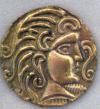"Let There Be Light" When The First Stars Blinked On

The very first stars may have turned on when the universe was 750 million years old.
As far back in time as astronomers have been able to see, the universe has had some trace of heavy elements, such as carbon and oxygen. These elements, originally churned from the explosion of massive stars, formed the building blocks for planetary bodies, and eventually for life on Earth.
Now researchers at MIT, the California Institute of Technology, and the University of California at San Diego have peered far back in time, to the era of the first stars and galaxies, and found matter with no discernible trace of heavy elements. To make this measurement, the team analyzed light from the most distant known quasar, a galactic nucleus more than 13 billion light-years from Earth.
Image: European Southern Observatory
These quasar observations provide a snapshot of our universe during its infancy, a mere 750 million years after the initial explosion that created the universe. Analysis of the quasar’s light spectrum provided no evidence of heavy elements in the surrounding gaseous cloud — a finding that suggests the quasar dates to an era nearing that of the universe’s first stars.
“The first stars will form in different spots in the universe … it’s not like they flashed on at the same time,” says Robert Simcoe, an associate professor of physics at MIT. “But this is the time that it starts getting interesting.”
Simcoe and his colleagues have published the results from their study this week in the journal Nature.
Hitting the universal wall
Based on numerous theoretical models, most scientists agree on a general sequence of events during the universe’s early development: Nearly 14 billion years ago, an immense explosion, now known as the Big Bang, threw off massive amounts of matter and energy, creating a rapidly expanding universe. In the minutes following the explosion, protons and neutrons collided in nuclear fusion reactions to form hydrogen and helium.
Eventually, the universe cooled to a point where fusion stopped generating these basic elements, leaving hydrogen as the dominant constituent of the universe. Heavier elements, such as carbon and oxygen, would not form until the first stars appeared.
Astronomers have attempted to identify the point at which the first stars were born by analyzing light from more distant bodies. (The farther away an object is in space, the older it is.) Until now, scientists have only been able to observe objects that are less than about 11 billion years old. These objects all exhibit heavy elements, suggesting stars were already plentiful, or at least well established, at that point in the universe’s history.
Image: European Southern Observatory/M. Kornmesser
“[The astrophysics community] sort of hit this wall,” says Simcoe, an astrophysicist at MIT’s Kavli Institute for Astrophysics and Space Research. “When this [quasar] was discovered, we could sort of leapfrog further back in time and make a measurement that was substantially earlier.”
Looking for nothing
The quasar in question, discovered in August 2011, is the most distant of its kind. To study such distant objects, Simcoe and his colleagues built an infrared spectrometer, which they fitted onto the Magellan Telescope, a massive ground-based telescope in Chile. This past January, the team trained the telescope on the newly discovered quasar, and collected data from its light.
The spectrometer split the incoming light into different wavelengths, which the team plotted on a graph. Simcoe then looked for telltale dips in the data, correlating various wavelengths with the light given off by different chemicals.
“Each chemical has its own fingerprint,” Simcoe says. “Based on the pattern of what light is absorbed, it tells you the chemical composition.”
Simcoe and his colleagues determined the quasar’s “intrinsic spectrum” — the amount of light naturally given off by such a body — and compared this with the observed data to search for the presence of heavy elements. The group found evidence of hydrogen, but no oxygen, silicon, iron or magnesium in the light data. But confirming the absence of evidence for heavy elements was a challenging task.
“It’s always hard to establish the absence of something,” Simcoe says.
To do so, the researchers considered every other scenario that might explain the light patterns they observed, including newborn galaxies and other matter situated in front of the quasar. Their efforts ultimately confirmed that the quasar’s light spectrum indicated an absence of heavy elements 750 million years after the Big Bang.
“[The birth of the first stars] is one of these important moments in the history of the universe,” Simcoe says. “It went from looking like the early universe, which was just gas and dark matter, to looking like it does today, where there are stars and galaxies … it’s the point when the universe started to resemble what it looks like today. And it’s sort of amazing how early that happens. It didn’t take long.”
John O’Meara, an associate professor of physics at St. Michael’s College in Vermont, says while scientists will have to analyze many more distant quasars to confirm the absence of heavy elements, the MIT group’s discovery is an “impressive and important step in advancing our knowledge of the universe when it was very young.”
“Prior to this result, we have not seen regions of the universe this old and devoid of heavy elements, so there was a missing link in our understanding of how the elemental content of the universe has evolved with time,” O’Meara adds. “[This] discovery possibly provides such a rare environment where the universe had yet to form stars.”
Going forward, Simcoe hopes to analyze other quasars from this early era to further confirm the absence of heavy elements.
“If we can find things in this epoch, we can start to characterize them,” Simcoe says. “There’s always something interesting at the edge.”
Contacts and sources: Jennifer Chu, MIT
More stories:
Time Reversal Technology Developed At University Of Maryland
UFO Crashes Off Okinawa, Japanese Navy Secures Area, Releases Photo
Aliens On Wildlife Cams In Two Different States
The Moon As Never Seen Before: GRAIL Reveals A Battered Lunar History
Video: UFO Over “Space Mountain” In France Where Aliens Will Emerge On Doomsday Say Believers
Optical Transistor 10,000 Times Faster Than World’s Fastest Electronic Transistor
New ’4-D’ Transistor Is Preview Of Future Computers
Synthetic Fuel Could Eliminate US Need For Crude Oil
The Solar Kill Shot, Remote Viewing, Mars, ETs, Dimensional Beings And Colonel Ed Dames
Number Of UFOs Around Sun Increased Since Last Week!
The Peak Of Eternal Light, Possible Lunar Base Site Where The Sun Never Sets
Major Earthquakes In Pacific Northwest and Himalayas Predict Stanford Scientists
Bold Gold Heist: Thieves Make Off With Millions, “Like A Movie Operation, Very Fast”
Twice The Ice On Titan: Vast Ocean Lies Beneath Icy Crust On Saturn’s Largest Moon
World’s Oldest Person Besse Cooper Passes At Age 116, Reveals Long Life Secrets
Death-Defying Comets Plunge Into The Sun’s Atmosphere
Sun’s Innermost Atmosphere Seen
Scum Villages Introduced In Europe, Forced Living In Containers For Undesirables
Black Marble: Unprecedented Views Of Earth At Night Released By NASA
Is QE3 Accelerating the World Hunger Crisis?
Anyone can join.
Anyone can contribute.
Anyone can become informed about their world.
"United We Stand" Click Here To Create Your Personal Citizen Journalist Account Today, Be Sure To Invite Your Friends.
Before It’s News® is a community of individuals who report on what’s going on around them, from all around the world. Anyone can join. Anyone can contribute. Anyone can become informed about their world. "United We Stand" Click Here To Create Your Personal Citizen Journalist Account Today, Be Sure To Invite Your Friends.
LION'S MANE PRODUCT
Try Our Lion’s Mane WHOLE MIND Nootropic Blend 60 Capsules
Mushrooms are having a moment. One fabulous fungus in particular, lion’s mane, may help improve memory, depression and anxiety symptoms. They are also an excellent source of nutrients that show promise as a therapy for dementia, and other neurodegenerative diseases. If you’re living with anxiety or depression, you may be curious about all the therapy options out there — including the natural ones.Our Lion’s Mane WHOLE MIND Nootropic Blend has been formulated to utilize the potency of Lion’s mane but also include the benefits of four other Highly Beneficial Mushrooms. Synergistically, they work together to Build your health through improving cognitive function and immunity regardless of your age. Our Nootropic not only improves your Cognitive Function and Activates your Immune System, but it benefits growth of Essential Gut Flora, further enhancing your Vitality.
Our Formula includes: Lion’s Mane Mushrooms which Increase Brain Power through nerve growth, lessen anxiety, reduce depression, and improve concentration. Its an excellent adaptogen, promotes sleep and improves immunity. Shiitake Mushrooms which Fight cancer cells and infectious disease, boost the immune system, promotes brain function, and serves as a source of B vitamins. Maitake Mushrooms which regulate blood sugar levels of diabetics, reduce hypertension and boosts the immune system. Reishi Mushrooms which Fight inflammation, liver disease, fatigue, tumor growth and cancer. They Improve skin disorders and soothes digestive problems, stomach ulcers and leaky gut syndrome. Chaga Mushrooms which have anti-aging effects, boost immune function, improve stamina and athletic performance, even act as a natural aphrodisiac, fighting diabetes and improving liver function. Try Our Lion’s Mane WHOLE MIND Nootropic Blend 60 Capsules Today. Be 100% Satisfied or Receive a Full Money Back Guarantee. Order Yours Today by Following This Link.






